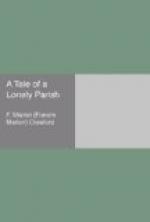“You mean about Mrs. Goddard? Well—no—I did not think it would interest you very much.”
“She is a very interesting person,” said John. He could have added that if he had known she was in Billingsfield he would have made a great sacrifice in order to come down for a day to make her acquaintance. But he did not say it.
“She is a great addition,” said the vicar.
“Oh—very great, I should think.”
Christmas eve was passed at the vicarage in preparation for the morrow. Mrs. Ambrose was very active in binding holly wherever it was possible to put it. The mince-pies were tasted and pronounced a success, and old Reynolds was despatched to the cottage with a small basket containing a certain number of them as a present to Mrs. Goddard. An emissary appeared from the Hall with a variety of articles which the squire begged to contribute towards the vicar’s Christmas dinner; among others a haunch of venison which Mrs. Ambrose pronounced to be in the best condition. The vicar retorted by sending to the Hall a magnificent Cottenham cheese which, as a former Fellow of Trinity, he had succeeded in obtaining. Moreover Mr. Ambrose himself descended to the cellar and brought up several bottles of Audit ale which he declared must be allowed to stand some time in the pantry in order to bring out the flavour and to be thoroughly settled. John gave his assistance wherever it was needed and enjoyed vastly the old-fashioned preparations for Christmas day. It was long since the season had brought him such rejoicing and he intended to rejoice with a good will towards men and especially towards the Ambroses. After dinner the whole party, consisting of three highly efficient persons and old Reynolds, adjourned to the church to complete the decorations for the morrow.
The church of Billingsfield, known as St. Mary’s, was quite large enough to contain twice the entire population of the parish. It was built upon a part of the foundations of an ancient abbey, and the vicar was very proud of the monument of a crusading Earl of Oxford which he had caused to be placed in the chancel, it having been discovered in the old chancel of the abbey in the park, far beyond the present limits of the church. The tower was the highest in the neighbourhood. The whole building was of gray rubble, irregular stones set together with a crumbling cement, and presented an appearance which, if not architecturally imposing, was at least sufficiently venerable. At the present time the aisles were full of heaped-up holly and wreaths; a few lamps and a considerable number of tallow candles shed a rather feeble light amongst the pillars; a crowd of school children, not yet washed for the morrow, were busy under the directions of the schoolmistress in decorating the chancel; Mr. Thomas Reid the conservative sexton was at the top of a tall ladder, presumably using doubtful language to himself as every third nail he tried to drive into the crevices of the stone “crooked




